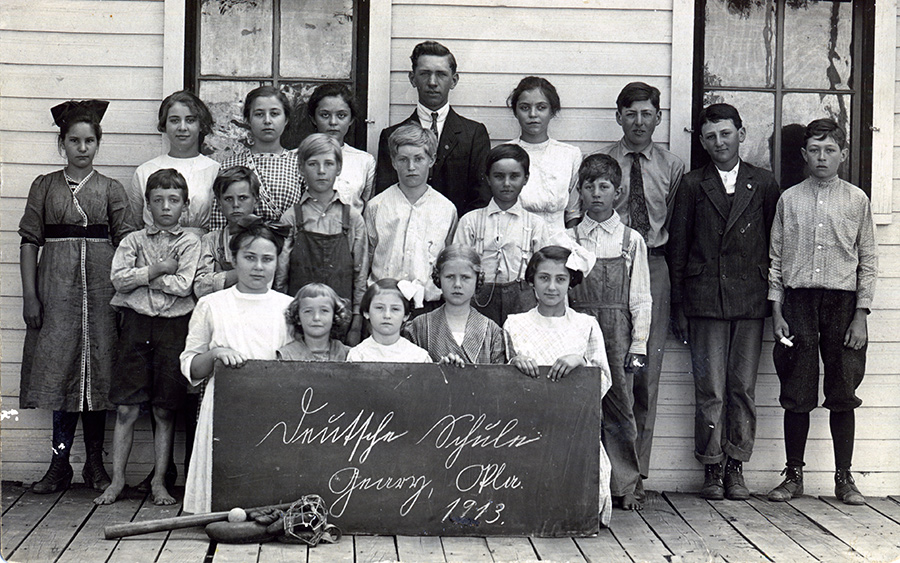
GERMANS.
The latter decades of the nineteenth century witnessed a massive migration of Germans to the United States. Their willingness to endure the hardships associated with leaving their homeland and traveling across the Atlantic Ocean to a new land resulted from both a desire to escape Germany and the attraction of a better life in America. Economic instability and frequent wars in Germany during the nineteenth century encouraged many to emigrate. As more Germans selected the United States as their destination, word spread back to Europe about the benefits of relocating. For some, it was the appeal of owning their own land or the chance of greater economic opportunity. For others, it was the prospect of joining relatives and friends who had emigrated earlier.
Few Germans who eventually settled in Oklahoma came to the state immediately after their arrival in the country. Most entered the United States through ports in the Northeast and then slowly migrated across the north-central states before settling in Oklahoma. Others, but far fewer, arrived in Texas or Louisiana before moving northward into Oklahoma. Regardless of their migration pattern, it was the prospect of land, a new start, or economic opportunity that attracted Germans to the Sooner State. Before statehood a few had settled in Indian and Oklahoma territories. Typically, they worked on the railroad or in coal mines or served as missionaries among the various Indian tribes.
By 1890 there were 739 German-born residents of Oklahoma Territory. A decade later the German-born exceeded five thousand, and that number more than doubled to ten thousand by 1910. In addition, by 1910 there were more than thirty thousand American-born Oklahomans whose mother and/or father had been born in Germany. Because much of the land in Oklahoma Territory was dispersed through land runs and lotteries, German-born residents were unable to concentrate in ethnic communities typical of other Great Plains states. Even at the height of German settlement in the state, the German-born population never exceeded 3 percent in any one county.
After their arrival in Oklahoma German-born newcomers established institutions to facilitate the preservation of their ethnic heritage and to help them cope with the isolation and hardships associated with frontier life. The most important of these were German-language churches, German-language newspapers, parochial schools with some or all classes taught in German, and social clubs. Between 1889 and 1920, for example, there were at least sixteen German-language newspapers published in the state.
The World War I period was particularly difficult for German residents. Although the initial response of the U.S. government to the outbreak of war in Europe was to declare neutrality, during the next several years the sympathies of the government and many Americans increasingly supported the Allies, who were at war with Germany and the other Central Powers. When the United States finally declared war on the Central Powers in April 1917, there was pressure on the Germans in Oklahoma to abandon obvious symbols of their cultural heritage. While there were isolated incidents of physical violence and destruction of property directed against them, the more enduring legacy of the wartime anti-German hysteria was the effect on their culture. Legal and extralegal policies forced Germans to stop speaking their native language in public and private conversations, stop worshiping in German, and stop reading German-language newspapers.
In the decades after World War I the size and settlement pattern of the German population of Oklahoma changed. First, the total number of German-born residents in the state declined. By 1920 the German population had dropped to 7,000, and by 1930 to 5,900. Second, more German residents left the rural areas of the state and began to concentrate in Oklahoma's two largest cities Oklahoma City and Tulsa. By 1930, 17 percent of the German population of the state resided in these two cities.
The World War II and postwar eras were less traumatic for German residents. There was far less anti–German American sentiment during World War II, as Americans' animosity now focused on residents of Japanese descent. After the war there was a renewed in-migration of Germans into the state. Some were religious or political refugees from wartime Germany, and others were the spouses of American servicemen stationed abroad after the war. Consequently, there was a resurgence of interest in German culture in Oklahoma during the 1960s. At the end of the twentieth century German clubs in Lawton, Oklahoma City, and Tulsa have celebrated such German festivals as Oktober Fest.






